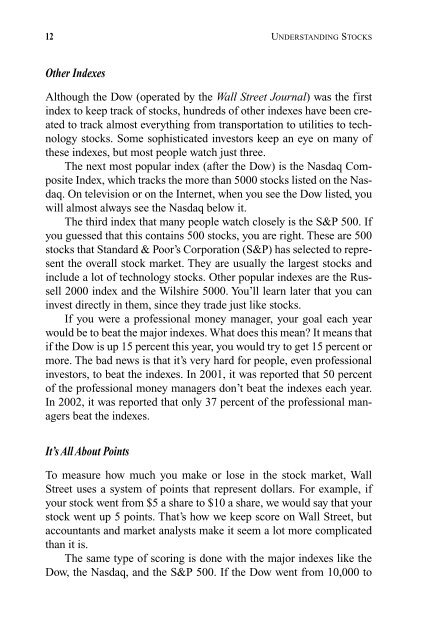Understanding Stocks
Understanding Stocks
Understanding Stocks
You also want an ePaper? Increase the reach of your titles
YUMPU automatically turns print PDFs into web optimized ePapers that Google loves.
12 UNDERSTANDING STOCKS<br />
Other Indexes<br />
Although the Dow (operated by the Wall Street Journal) was the first<br />
index to keep track of stocks, hundreds of other indexes have been created<br />
to track almost everything from transportation to utilities to technology<br />
stocks. Some sophisticated investors keep an eye on many of<br />
these indexes, but most people watch just three.<br />
The next most popular index (after the Dow) is the Nasdaq Composite<br />
Index, which tracks the more than 5000 stocks listed on the Nasdaq.<br />
On television or on the Internet, when you see the Dow listed, you<br />
will almost always see the Nasdaq below it.<br />
The third index that many people watch closely is the S&P 500. If<br />
you guessed that this contains 500 stocks, you are right. These are 500<br />
stocks that Standard & Poor’s Corporation (S&P) has selected to represent<br />
the overall stock market. They are usually the largest stocks and<br />
include a lot of technology stocks. Other popular indexes are the Russell<br />
2000 index and the Wilshire 5000. You’ll learn later that you can<br />
invest directly in them, since they trade just like stocks.<br />
If you were a professional money manager, your goal each year<br />
would be to beat the major indexes. What does this mean? It means that<br />
if the Dow is up 15 percent this year, you would try to get 15 percent or<br />
more. The bad news is that it’s very hard for people, even professional<br />
investors, to beat the indexes. In 2001, it was reported that 50 percent<br />
of the professional money managers don’t beat the indexes each year.<br />
In 2002, it was reported that only 37 percent of the professional managers<br />
beat the indexes.<br />
It’s All About Points<br />
To measure how much you make or lose in the stock market, Wall<br />
Street uses a system of points that represent dollars. For example, if<br />
your stock went from $5 a share to $10 a share, we would say that your<br />
stock went up 5 points. That’s how we keep score on Wall Street, but<br />
accountants and market analysts make it seem a lot more complicated<br />
than it is.<br />
The same type of scoring is done with the major indexes like the<br />
Dow, the Nasdaq, and the S&P 500. If the Dow went from 10,000 to

















